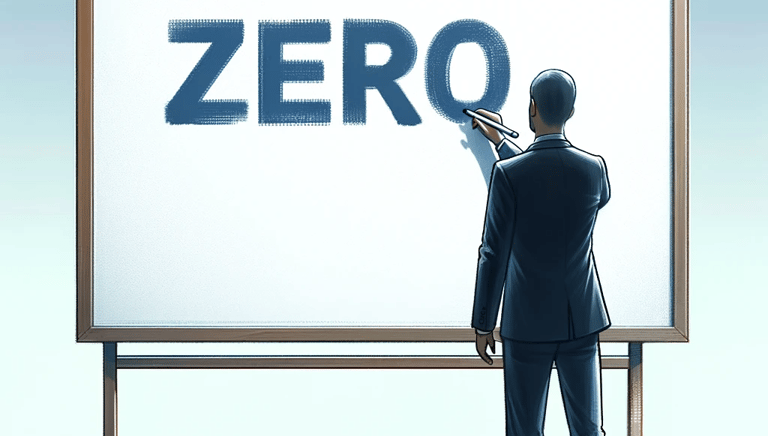Prepare For New Year With Zero Based Thinking
12/25/20233 min read
Harnessing the Power of Zero-Based Thinking for Better Decision-Making
The choices we made yesterday might not always be the best ones for today or tomorrow in a world that is ever changing. Here's where the idea of zero-based thinking—popularized by author and motivational speaker Brian Tracy—becomes a game-changer for advancement on the personal and professional fronts.
Zero-Based Thinking: What is It?
The concept of zero-based thinking originates from the accounting technique known as zero-based budgeting, in which each new period's expenses must be justified, beginning from a "zero base." This idea was adopted by Brian Tracy and used in strategic planning and decision-making. "If I was not now doing this, knowing what I now know, would I get involved in this area again?" is the central query of zero-based thinking. This approach is also known as a KWINK (Knowing What I Now Know) analysis. (14 Zero-Based Thinking - Business Strategy (the Brian Tracy Success Library) [Book], n.d.) & (Oppong, 2019)
The Power of Reflection and Reassessment
The strength and simplicity of zero-based thinking are its greatest features. It enables us to use hindsight constructively, not only as a tool for regret but also to help us make better judgments in the future. We create opportunities to reassess our previous decisions and present tactics by considering what we would do differently if we could start over with the knowledge we currently possess.
Applying Zero-Based Thinking in Everyday Life
The application of zero-based thinking can revolutionize a number of facets of life and work:
In Personal Finances: It can be applied to review saving plans, spending patterns, and investment strategies. It might be time to change course if, with what you now know, you wouldn't make the same financial decisions.
In terms of career development, this method can help you think back on the jobs you've taken on, the projects you've worked on, and the connections you've made in the business world.
In Business Strategy: When it comes to hiring, project management, and resource allocation, leaders and entrepreneurs often find that zero-based thinking is essential.
The Agility to Pivot
The market of today, which is marked by unpredictability and volatility, necessitates flexibility and the capacity to quickly change course. Zero-based thinking pushes us to continuously evaluate and adjust rather than being mired in a pattern of prior choices. Not only should one consider prior successes, but also what is most advantageous for the present and future. (Zero-Based Thinking: What Is It and How Can Finance Leaders Use It?, n.d.)
Zero-Based Thinking vs. Zero-Based Budgeting
Zero-based thinking and zero-based budgeting are two different concepts, although having the same name. Zero-based thinking is more broadly applicable to all decision-making processes, while zero-based budgeting concentrates particularly on financial planning, beginning each budget from zero. (Zero-Based Thinking: What Is It and How Can Finance Leaders Use It?, n.d.)
How to Put Zero-Based Thinking Into Practice
Analyze the Situation: Begin by assessing what is and is not working for you in your current situation.
Pose the Zero-Based Question: "Would I make the same choice again, knowing what I know now?"
Be Ready to Change Course: If the response is negative, be prepared to adjust, even if it involves going back and changing previous choices.
Conclusion
Zero-based thinking provides a solid basis for more intelligent, flexible decision-making. This method pushes us to let go of the consequences of our past decisions and concentrate on what is actually helpful in the here and now. By adopting this mentality, we can walk through life with greater assurance and clarity, making sure that our choices and actions are in line with our knowledge and aspirations right now.
Zero-based thinking is a philosophy that promotes ongoing learning, adaptability, and development rather than merely a method of decision-making. By putting this strategy into practice, people and organizations can make sure they're not simply keeping up with the times, but also well-positioned to prosper in a world that is changing quickly.
References
14 Zero-Based Thinking - Business Strategy (The Brian Tracy Success Library) [Book]. (n.d.). Www.oreilly.com. Retrieved December 25, 2023, from https://www.oreilly.com/library/view/business-strategy-the/9780814436271/xhtml/chapter14.html
Oppong, T. (2019, December 5). Zero-Based Thinking: Principles For Making Better Life Decisions. Thrive Global. https://community.thriveglobal.com/zero-based-thinking-principles-making-better-life-decisions-career-growth-wisdom-advice/
Zero-Based Thinking: What Is It and How Can Finance Leaders Use It? (n.d.). Www.venasolutions.com. Retrieved December 25, 2023, from https://www.venasolutions.com/blog/what-is-zero-based-thinking
Zero-Based Thinking: What Is It and How Can Finance Leaders Use It? (n.d.). Www.venasolutions.com. Retrieved December 25, 2023, from https://www.venasolutions.com/blog/what-is-zero-based-thinking

